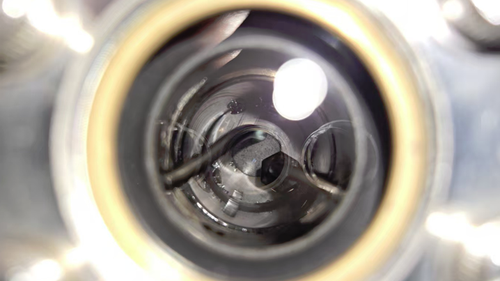<div class="block-content"><div class="styles__Container-sc-1ylecsg-0 goULFa"><span>Scientists say they've developed a technology that could help people survive on the moon.</span></div></div><div class="block-content"><div class="styles__Container-sc-1ylecsg-0 goULFa"><span>In a new study, published today in the Cell Press journal Joule, Chinese researchers were able to extract water from lunar soil and use it to convert carbon dioxide into oxygen and chemicals for fuel.</span></div></div><div class="block-content"><div class="styles__Container-sc-1ylecsg-0 goULFa"><span>This could potentially open new doors for future deep space exploration by ensuring Earth doesn't remain the only supplier of essential resources like water and fuel.</span></div></div><div><div id="adspot-mobile-medium"></div></div><div class="block-content"><div class="styles__Container-sc-1ylecsg-0 goULFa"><span>"We never fully imagined the 'magic' that the lunar soil possessed," Lu Wang of the Chinese University of Hong Kong, Shenzhen, said.</span></div></div><div class="block-content"><div class="styles__Container-sc-1ylecsg-0 goULFa"><span>"The biggest surprise for us was the tangible success of this integrated approach. </span></div></div><div class="block-content"><div class="styles__Container-sc-1ylecsg-0 goULFa"><span>"The one-step integration of lunar H2O extraction and photothermal CO2 catalysis could enhance energy utilisation efficiency and decrease the cost and complexity of infrastructure development."</span></div></div><div class="block-content"><div class="styles__Container-sc-1ylecsg-0 goULFa"><span>Space agencies have floated the idea of using the Moon as an outpost for far-flung explorations of the cosmos for decades.</span></div></div><div><div class="OUTBRAIN" data-reactroot="" data-src="//www.9news.com.au/world/lunar-soil-could-support-life-on-the-moon-new-research-claims/9ad04d1b-c8f8-49be-8d6e-90550d82c013" data-widget-id="AR_5"></div></div><div class="block-content"><div class="styles__Container-sc-1ylecsg-0 goULFa"><span>However, the need to supply such a base with adequate resources to support its inhabitants – especially water – has been a barrier to making it a reality. </span></div></div><div class="block-content"><div class="styles__Container-sc-1ylecsg-0 goULFa"><span>A single gallon of water costs about US$83,000 ($126,378) to ship by rocket, according to the study, with each astronaut drinking about four gallons per day.</span></div></div><div class="block-content"><div class="styles__Container-sc-1ylecsg-0 goULFa"><span>One gallon is about 3.7 litres.</span></div></div><div class="block-content"><div class="styles__Container-sc-1ylecsg-0 goULFa"><span>Previously developed strategies for extracting water from lunar soil involved multiple energy-intensive steps and didn't break down CO2 for fuel and other essential uses.</span></div></div><div class="block-content"><div class="styles__Container-sc-1ylecsg-0 goULFa"><span>To advance this research, Wang and colleagues developed a technology that would both extract water from lunar soil and directly use it to convert the CO2 exhaled by astronauts into carbon monoxide (CO) and hydrogen gas, which could then be used to make fuels and oxygen for the astronauts to breathe.</span></div></div><div class="block-content"><div class="styles__Container-sc-1ylecsg-0 goULFa"><span>The technology accomplishes this feat through a novel photothermal strategy, which converts light from the Sun into heat.</span></div></div><div class="block-content"><div class="styles__Container-sc-1ylecsg-0 goULFa"><span>Despite success in the lab, the extreme lunar environment still poses challenges that will complicate its usage on the moon, according to the authors, including drastic temperature fluctuations, intense radiation, and low gravity.</span></div></div><div class="styles__Wrapper-sc-2o34ro-0 cmwkBV"><div class="styles__Column-sc-2o34ro-3 jJDKrX"><a href="/technology/2017/07/14/11/09/nasa-space-photos-stars-planets"><img alt="" sizes="(min-width: 1024px) 636px, (min-width: 768px) 396px, 100vw" src="https://imageresizer.static9.net.au/W1jyB3wTIQByWveIk39e7Au1i18=/305x0:2000x953/396x223/https%3A%2F%2Fprod.static9.net.au%2Ffs%2F2fa18117-6648-460e-86e4-1013b2af1f0f" srcset="https://imageresizer.static9.net.au/W1jyB3wTIQByWveIk39e7Au1i18=/305x0:2000x953/396x223/https%3A%2F%2Fprod.static9.net.au%2Ffs%2F2fa18117-6648-460e-86e4-1013b2af1f0f 396w, https://imageresizer.static9.net.au/CUK5GylHAZmsEZLjTOYzTjIP6fU=/305x0:2000x953/636x358/https%3A%2F%2Fprod.static9.net.au%2Ffs%2F2fa18117-6648-460e-86e4-1013b2af1f0f 636w"/></a></div><div class="styles__Column-sc-2o34ro-3 jJDKrX"><div class="styles__Headline-sc-2o34ro-4 hpbOlz">Lander's incredible close-up shot of the moon's hidden side</div><div class="styles__Button-sc-2o34ro-1 eBjlmW"><a class="styles__ButtonLink-sc-2o34ro-2 hqpklJ" href="/technology/2017/07/14/11/09/nasa-space-photos-stars-planets">View Gallery</a></div></div></div><div class="block-content"><div class="styles__Container-sc-1ylecsg-0 goULFa"><span>Also, lunar soil in its natural environment does not have a uniform composition, which leads to it having inconsistent properties, while CO2 from astronauts' exhalations might not be enough to offer a basis for all the water, fuel, and oxygen they need.</span></div></div><div class="block-content"><div class="styles__Container-sc-1ylecsg-0 goULFa"><span>Technological limitations also continue to present a barrier, with current catalytic performance still insufficient to fully support human life in environments beyond Earth, said Wang.</span></div></div><div class="block-content"><div class="styles__Container-sc-1ylecsg-0 goULFa"><span>"Overcoming these technical hurdles and significant associated costs in development, deployment, and operation will be crucial to realising sustainable lunar water utilisation and space exploration," the authors write.</span></div></div><div class="block-content"><div class="styles__Container-sc-1ylecsg-0 goULFa"><a href="https://www.9news.com.au/national/how-to-follow-9news-digital/29855bb1-ad3d-4c38-bc25-3cb52af1216f" target="_blank"><strong><em><span>DOWNLOAD THE 9NEWS APP</span></em></strong></a><strong><em><span>: Stay across all the latest in breaking news, sport, politics and the weather via our news app and get notifications sent straight to your smartphone. Available on the</span></em></strong><span> </span><a href="https://apps.apple.com/au/app/9news/id1010533727" target="_blank"><strong><em><span>Apple App Store</span></em></strong></a><span> </span><strong><em><span>and</span></em></strong><span> </span><a href="https://play.google.com/store/apps/details?id=nineNewsAlerts.nine.com&hl=en_AU&pli=1" target="_blank"><strong><em><span>Google Play</span></em></strong></a><strong><em><span>.</span></em></strong></div></div>
'Magic' new breakthrough could help support life on the moon

Leave A Reply
Your email address will not be published.*